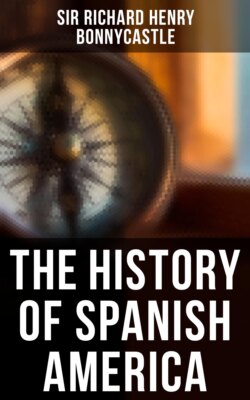Читать книгу The History of Spanish America - Sir Richard Henry Bonnycastle - Страница 24
На сайте Литреса книга снята с продажи.
INTENDANCY OF NEW BISCAY OR DURANGO.
ОглавлениеTable of Contents
In quitting Sonora, on the east, we find the province and intendancy of New Biscay or Durango, which is bounded on the north by New Mexico and Indian nations, on the east by a desert country between it and Coaguila, on the west by Sonora, and on the south by Zacatecas and Guadalaxara, or New Gallicia. It is about 100 miles in medial breadth, and 690 in length. The great ridge or Cordillera of Sierra Madre crosses it in its whole length, and the whole country is very mountainous, well watered by small rivers, the climate temperate, the soil fertile, the cattle fine and numerous, and the mountains abounding in ores. This intendancy has a population of 159,000 souls.
The country near New Biscay contains several small marshes, in the islands or firm ground of which the Indians bid defiance to their Spanish neighbours, and are so hostile, that many forts have been built along the country to prevent their incursions.
The capital is Durango, which is the farthest town of any consequence north of Mexico; it is situated on a river which empties itself into a lake, (the river is called Durango or Guadiana).
The population of this city amounts to 12,000. It is the see of a bishop, which is very extensive; in his jurisdiction all the western interior provinces, comprehending those on the east shore of the Californian gulf, are included. It was erected in the year 1620. The tithes of this see are said to have amounted in ten years to 1,080,300 dollars.
A branch of the royal treasury of Mexico is established here for collecting the duties on the mines. The climate in the neighbourhood of this city is mild and healthy, and the country fertile, producing corn, maize and fruit, and pasturing fine cattle. It has three churches and four convents, and is 170 leagues from Mexico, and 298 from Santa Fé. Durango is elevated 6845 feet above the level of the sea, and the intendant or governor of the province resides here.
The inhabitants of New Biscay are all whites, there being no Indians amongst them; they are a people of robust constitution and good intellectual qualities.
They live in a state of constant warfare with their neighbours the Indians, particularly with the Cumanches, a very warlike race of people, who bear an inveterate hatred to the Spaniards. A tract of desert country to the west, called the Bolson de Mapimi, is inhabited by the Acoclames, the Cocoyames, the Apaches Mezcleros, and Apaches Fardones. It is from this waste that the natives are principally annoyed by the Indians; in it is a large lake called Cayman, and part of another called Parras.
The Rio Conchos is the largest river of New Biscay, which rises in the Sierra Madre, and after taking a southerly course, suddenly turns to the east, and again to the north, and empties itself into the Rio del Norte, at the Fort de las Juntas. New Biscay has six towns and 199 villages, with innumerable stations and farms.
The towns of New Biscay of the greatest note after Durango, are Chihuahua, formerly the residence of the captain-general of all the interior provinces of the upper part of the viceroyalty of New Spain, and now the residence of the captain-general of the western interior provinces, which comprehend New Biscay, New Mexico, Sonora, and the two Californias. The population of Chihuahua is 11,600, and it is surrounded with mining stations, the principal of which is Santa Rosa de Cosiquiriachi, where that part of the Sierra Madre, called De los Metales, has valuable and numerous silver mines; this mining station is peopled by 10,700 souls.
Mapimis, on the south extremity of the desert of Mapimi, is a military port, with 2700 inhabitants.
St. Juan del Rio, south of Lake Parras, 10,200 souls.
Saltillo, situated to the west of Monterey, in New Leon, on a barren dry soil; 6000 people.
Pasquaro, south of Rio de Nasas; 5600.
Batopilas, west of Rio Conchos, 8000, formerly a place of great repute for its mines.
Parral the seat of a council of mines, 5000, and the mining station of Guirisamey, 3800.
The population of this government is concentrated entirely in these towns and in the mining stations, as in New Mexico, the warlike Indians rendering this method of living necessary; even the forts are well peopled, as the settlers choose to live under their protection, in preference to possessing large tracts of land at a distance from any defence.
